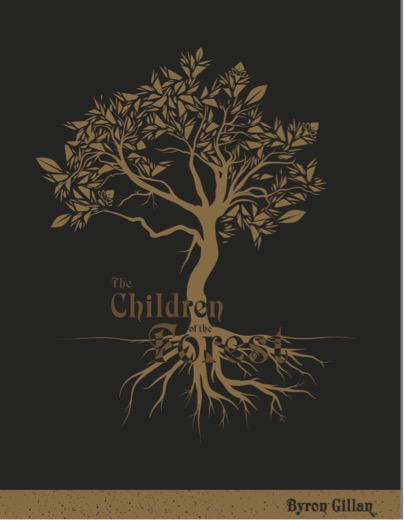My guest today is Byron Gillan, author of The Children of the Forest, currently funding on Inkshares.
 Byron Gillan is an avid reader, recent college graduate, and freelance writer, with multiple publications in various newspapers, magazines, and online publications, including work for the Buffalo News. His first novel, The Children of the Forest, is currently seeking crowd-sourcing through Inkshares.com, and was recently entered in the Nerdist.com writing contest. Byron focuses primarily on Fantasy, Horror, and Science-Fiction, and enjoys blending the various genres together to create something new. His writing seeks to ask difficult and important questions about pressing social issues, such as race, environmentalism, religion, and more, exploring them through the lens of his favorite genres.
Byron Gillan is an avid reader, recent college graduate, and freelance writer, with multiple publications in various newspapers, magazines, and online publications, including work for the Buffalo News. His first novel, The Children of the Forest, is currently seeking crowd-sourcing through Inkshares.com, and was recently entered in the Nerdist.com writing contest. Byron focuses primarily on Fantasy, Horror, and Science-Fiction, and enjoys blending the various genres together to create something new. His writing seeks to ask difficult and important questions about pressing social issues, such as race, environmentalism, religion, and more, exploring them through the lens of his favorite genres.
Here now are Byron’s insights on world building.
What is the appeal of world building to you? How does it compare to the importance of character and plot?
To me, world building is something authors should use as an extension of their plot. Personally, I’ve always loved detailed worlds, but all too often, that detail comes at the cost of the narrative. Too many writers feel the urge to overburden their readers with extraneous details that don’t even relate to the central philosophy or ideology of the story they’re trying to tell. In other words, the world building ends up just getting in the way of the actual story.
When I set out to write my first novel, The Children of the Forest, I wanted to focus on the theme, characters, and overarching storyline, rather than filling endless pages with frivolous details that wouldn’t directly relate back to the main purpose of the novel, which was primarily to deliver a commentary on man and his relationship to his environment.
This isn’t to say that I don’t love world building, quite the contrary, nothing brings me into a story, or hooks my attention as quickly as strong description of culture, place, or history; it’s just that it has to be done well. A single sentence, delivered during a moment of quiet between two characters, if written properly, can offer the reader far more than two or three pages, going on endlessly about the food sitting on the table, or the design of a character’s particular dress.
The old adage “less is more”, could not be more appropriate for the writer’s and world-building.
What aspects of the world do you have to figure out before you start a story? What do you allow to unfold as you write?
The Children of the Forest, as I already mentioned, was primarily written as a personal response to many of the critiques I had with the “Epic-Fantasy” genre. I felt that too many authors were getting bogged down in the details of their world, and becoming too focused on expanding their complicated creations rather than organically allowing their universes to expand around their novel’s stories. In my novel, I approached this issue by setting the story in a “post-apocalyptic” setting, where civilization has been uprooted and all-but eradicated after a cataclysmic event referenced only as “the Collapse”.
By setting the story some 400 odd years after this devastation, I managed to create a setting free of many of the hurdles faced by authors who are attempting to introduce a complicated, brand new world to their audience. When the story begins, readers know only slightly less than the inhabitants of Midgar, and their sense of confusion, and intrigue, in regards to the past of this decaying world, mirrors the characters inhabiting it; almost all of whom are themselves unaware of what exactly transpired to bring about civilization’s fall.
This allowed me quite a bit of freedom with the actual world-building of the CotF universe. I created a crude (crude being quite kind) map of the known world, and labeled the various tribes, and other political entities inhabiting it. Beyond that, only basic geographical landmarks and such were jotted down where I felt they were important or required. Beyond that, I was free to let the details reveal themselves as I set to work on the story. Essentially, I was free to organically craft each culture as they were introduced, and this allowed for a very natural process. Instead of creating a rigid and uniform identity for each faction, culture, or species, I allowed the uniqueness of my world to expand from the actual story, and I couldn’t be happier with the results.
Do you have a technique for keeping track of world building as you go? How do you ensure your material is easily retrievable and easy to modify?
I think it’s important to keep in mind that every writer is different. The way one person works might only work for that one individual, and world building is no different. Some authors I’m personally familiar with, cannot do anything unless they’ve spent hours, days, weeks, etc. plotting out every last little detail known to man. Others fall somewhere in the middle, creating perhaps a rough outline of major ideas, religious practices, and such, before diving in and letting the rest come to them more naturally.
At the end of the day, there’s really no right or wrong answer to the question of “What is the proper way to build your world?”. That being said, I do believe that there is a difference between “good world building” and “bad”. Good world building doesn’t overburden your audience with the what is known as “info-dump”. No one wants to be buried under the weight of thousands of words of minutia, detailing the most rudimentary parts of your world’s existence. Readers want an engaging story, good characters, and a glimmer of a world different from their own, not the boring details they already suffer through in their everyday, real-world lives. Unless they’re a masochist, like the type of readers who read through the entirety of The Wheel of Time series (guilty).
Be sure to check out Byron’s novel, The Children of the Forest:
 Faced with the ecological collapse of her world, a young princess must embark on a perilous journey to save her kingdom from ruin. The Children of the Forest is a contemplative, Science-Fantasy duology, exploring the tenuous balance of man and nature, and the conflicts that inevitably arise from that precarious relationship.
Faced with the ecological collapse of her world, a young princess must embark on a perilous journey to save her kingdom from ruin. The Children of the Forest is a contemplative, Science-Fantasy duology, exploring the tenuous balance of man and nature, and the conflicts that inevitably arise from that precarious relationship.
You can read the opening scene of The Children of the Forest over on Tablo.
If you’re intrigued, please go over to Inkshares to find out more.
Inkshares is a crowdfunding publisher who chooses which books to publish based on whether enough readers have shown interest in them. Successful projects have been reviewed in the NYT, US Today, and Washington Post, and have been distributed to numerous bookstores including Indigo and Barnes & Noble.
Connect with Byron in the following places:
Twitter: @ByronGWriterGuy
Facebook: https://www.facebook.com/TheChildrenoftheForest?pnref=story
Goodreads: https://www.goodreads.com/user/show/46833458-byron

